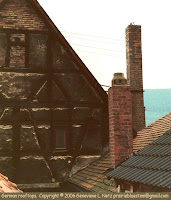A letter home from West Berlin
 I wrote this letter 6 days before our son Isaac was born. Keely was 3 years old. We were living in military housing (Duepple Housing area) in West Berlin, on the ground floor of an apartment building that was 6 or 7 stories high. Dennis was working for the PX system (AAFES).
I wrote this letter 6 days before our son Isaac was born. Keely was 3 years old. We were living in military housing (Duepple Housing area) in West Berlin, on the ground floor of an apartment building that was 6 or 7 stories high. Dennis was working for the PX system (AAFES).
Berlin
June 7, 1989
Dear Daddy, Mama, and all the family,
I'll write a few lines while Keely watches
Sesame Street and Dennis snoozes.
Dennis was off work today, so we took Keely to the beach -- the shore of the Wannsee, which is a large lake just a few miles from us. Keely wore her swimsuit and waded a bit at the water's edge, but she wasn't at all adventurous about getting wet above her knees. Dennis and I parked ourselves in our lawn chairs, and Keely had a good time filling her sand bucket with various mixtures of sand and water.
The sky clouded over, and it looked rainy, so we left after an hour, just before it got seriously wet. Maybe it was the approaching rainstorm that made the swans so frisky today. All the time we were there, they were opening their wings and flapping across the water.
As you know, Willadene and Lewis
(Dennis's sister and her husband) were here last week. We went to various places in the city with them that we hadn't visited before -- the stadium that was built for the 1936 Olympics, an interesting flea and antique market in some old subway cars at one of the stations, and St. Hedwig's Cathedral. The cathedral is in East Berlin, and the stadium and flea market are in West Berlin.
Also in East Berlin, we saw the weekly parade of East German soldiers in front of their Tomb of the Unknown Soldier. They goosestep new guards in and out every hour, but each Wednesday at 2:30, the whole company has a elaborate ceremony and parade on the street in front of the monument.
After being so warm in May, it's turned cool again. They've even turned on the heat again. It's been below 50° several nights.
I hope that by the time you actually receive this letter, maybe we'll have the baby. The day we went to East Berlin and walked for miles, I wondered if maybe we would need to rush to the hospital. (I didn't say a word to Dennis and the group about it, because I didn't want to get everyone excited!) But I'm still waiting. I have my suitcase partially packed.
Laveda Boggs, another AAFES wife who lives one floor above us, has offered repeatedly to watch Keely if we have to go to the hospital suddenly in the night. She works during the day, so we've made arrangements with another lady (Linda) to keep Keely while Dennis is at work. Linda is trustworthy and has three preschoolers of her own. Keely and I have visited at their house several times recently so Keely won't feel like a stranger.
Keely has been wanting to learn to "spreche Deutsch" lately. She has become aware that she and the little German kids speak two different languages. She's been asking me to teach her. When we finish a little lesson, she says, "NOW those kids will understand what I'm saying!"
We went today to see about enrolling Keely in preschool next fall at the John F. Kennedy School. It's a private school, and we will have to pay tuition. We will have to pay her tuition at any preschool, so why not try for one of the better ones? They teach preschool mainly in German. We couldn't find anyone at the school because they're all on a week's vacation, so we will have to try again. They have a waiting list, and I wouldn't want her to begin before next fall anyway. With the baby, that will be enough adjusting and stress for her at present.
Well, I don't have enough news to begin another page, so I'll sign off. All's well here, and we hope you are doing OK too! Love from each of us, and juicy Keely-kisses all around.
Gennie, Dennis, and Keely
While predictions of a mild winter prevailed in the fall, meteorologist Joe Bastardi of AccuWeather is now predicting that the United States will have the worst winter in 25 years.



 Dennis and I didn't fool around with making guacamole. We cut the avocados in half and ate the soft meat with a spoon right out of the skins. Sometimes we spread mashed avocado like butter on the fresh rolls that the bakery peddler sold out of the basket on the back of his bicycle.
Dennis and I didn't fool around with making guacamole. We cut the avocados in half and ate the soft meat with a spoon right out of the skins. Sometimes we spread mashed avocado like butter on the fresh rolls that the bakery peddler sold out of the basket on the back of his bicycle.




